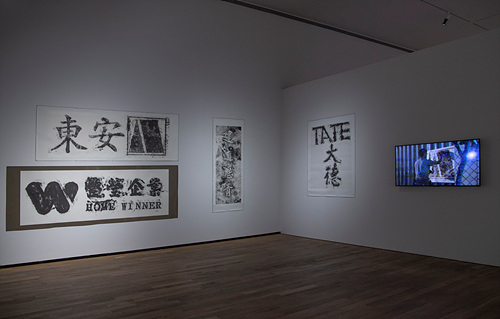
Industrial Rubbing
Lee Yungchih
This space features Industrial Rubbing, a work by Taiwanese artist Lee Yung-Chih.
Lee’s practice begins with the industrial landscapes of his hometown—its sounds, fragments of metal, and decaying signage. His childhood memories are interwoven with traces of urban change, forming the foundation for his exploration of capitalism, labor, and identity in contemporary society.
A key concept in his work is the idea of daoban (盜版), a Chinese term commonly translated as “piracy” or “unauthorized reproduction.” For Lee, however, daoban serves as more than a literal reference to bootlegging—it becomes a cultural metaphor.
Referencing Taiwan’s era as the so-called “pirate kingdom,” Lee invokes this history not only with irony but with critical attention to the economic transitions and structural shifts that defined the period. His work reflects on what was replicated, what was lost, and what continues to haunt the social fabric.
The Industrial Rubbing series involves the act of taking rubbings from abandoned factories, rusted machinery, and industrial debris—or collecting and reassembling these materials into new configurations. Through this process, Lee reconnects forgotten histories of labor and industrialization with the present conditions of urban life.
These works are not simply nostalgic recollections. They contain the fractures and tensions between past, present, and future—visualizing the parallel trajectories of modernization across East Asia. In this sense, the work resonates deeply with the theme of this Biennale, Neighbors of Civilization.
Separated by the Yellow Sea, both Taiwan and South Korea have undergone rapid industrialization and identity crises—histories that rise to the surface through Lee’s tactile, resonant images.
By transforming discarded remnants into aesthetic form, Lee Yung-Chih invites us to look again at the fragments of our cities—things once overlooked or forgotten.
Within these worn traces, he unearths a shared memory and a sensory solidarity that links bodies, places, and histories across borders.
Lee’s practice begins with the industrial landscapes of his hometown—its sounds, fragments of metal, and decaying signage. His childhood memories are interwoven with traces of urban change, forming the foundation for his exploration of capitalism, labor, and identity in contemporary society.
A key concept in his work is the idea of daoban (盜版), a Chinese term commonly translated as “piracy” or “unauthorized reproduction.” For Lee, however, daoban serves as more than a literal reference to bootlegging—it becomes a cultural metaphor.
Referencing Taiwan’s era as the so-called “pirate kingdom,” Lee invokes this history not only with irony but with critical attention to the economic transitions and structural shifts that defined the period. His work reflects on what was replicated, what was lost, and what continues to haunt the social fabric.
The Industrial Rubbing series involves the act of taking rubbings from abandoned factories, rusted machinery, and industrial debris—or collecting and reassembling these materials into new configurations. Through this process, Lee reconnects forgotten histories of labor and industrialization with the present conditions of urban life.
These works are not simply nostalgic recollections. They contain the fractures and tensions between past, present, and future—visualizing the parallel trajectories of modernization across East Asia. In this sense, the work resonates deeply with the theme of this Biennale, Neighbors of Civilization.
Separated by the Yellow Sea, both Taiwan and South Korea have undergone rapid industrialization and identity crises—histories that rise to the surface through Lee’s tactile, resonant images.
By transforming discarded remnants into aesthetic form, Lee Yung-Chih invites us to look again at the fragments of our cities—things once overlooked or forgotten.
Within these worn traces, he unearths a shared memory and a sensory solidarity that links bodies, places, and histories across borders.
